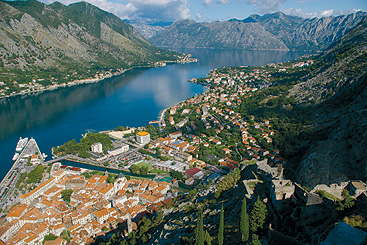
Experience from the Danube River Basin for
the Mediterranean Sea
The ICPDR was presented to countries in the Mediterranean as an example of an efficient region body for implementing an international convention.

The Mediterranean Action Plan brings together 21 countries to improve maritime ecosystem management, with inspiration from the ICPDR.
The Mediterranean Action Plan (MAP) is the first programme in the world established for the protection of a regional sea and includes 21 contracting parties and representation by the EU. In an effort to improve the efficiency of the maritime ecosystem management, Slovenia, currently holding the presidency of the MAP Bureau, organised a meet-ing, Strengthening the Regional Cooperation for Shared Water Resources, to present a model for the implementation of an international convention – the ICPDR.
The ICPDR as role model. At the invitation of Janez Podobnik, Slovenian Minster for the Environment and Spatial Planning, ICPDR Executive Secretary Philip Weller, Secretary of the International Commission for the Sava River Basin Dejan Komatina, Mediterranean Action Plan Coordinator Paul Mifsud, EU representative Andrew Murphy, and representatives of the Adriatic coastal states and the Regional Environmental Centre (REC) from Budapest met at the Institute for Karst Research in Postojna, Slovenia.
Presentations covered the ICPDR’s achievements and the special role of sub-regional efforts to strengthen cross-border cooperation in the basin, particularly the Framework Agreement for the Sava River Basin. The objective of the meeting was to increase efficiency of MAP operations, and to exchange experience with the ICPDR. “There is no need to reinvent the wheel. All lessons we can share, we should share – for the benefit of the region and the people living there,” said Mifsud.
Highlighting support. The active role of the REC, which served as Interim Secretariat in the process of preparing the Framework Agreement for the Sava River Basin, was also emphasised to the MAP Bureau. Stephen Stec, head of REC’s Environmental Law Programme, outlined how REC could help in the Adriatic. “With the ‘Adriatic Sea Partnership Project` REC can offer to strengthen the current institutional arrangements to enhance cooperation and to facilitate real actions. Countries could meet their commitments, such as the determination of the Particularly Sensitive Sea Areas or the development of the integrated coastal zone management plan,” said Stec.
The location of the meeting was ideal, as Postojna is in the heartland of the Dinara ecoregion, which stretches from the Alps to the Peloponnesus, and is probably the most intensively studied karst region in the world. This particular karst region links the Danube Basin with the Mediterranean due to its specific hydromorphology and is highly vulnerable to pollution.
THE MEDITERRANEAN AT A GLANCE
- The Mediterranean covers more than 2.5 million km2, and has 46,000 km of coastline.
- The population is over 425 million, with 150 million
living along the coast, and an additional 170 million tourists visit each year. - Some 48% of urban centres lack sewage treatment
facilities and around 80% of wastewater is disposed in the sea untreated. - Some 60 petrol refineries dump nearly 20,000 tonnes of petrol into the sea each year.
For more information, please visit
www.unepmap.org
Disclaimer
The information contained in the ICPDR website is intended to enhance public access to information about the ICPDR and the Danube River. The information is correct to the best of the knowledge of the ICPDR Secretariat. If errors are brought to our attention we will try to correct them.
The ICPDR, expert group members, nor other parties involved in preparation of information contained on this website cannot, however, be held responsible for the correctness and validity of the data and information provided, nor accept responsibility or liability for damages or losses arising directly or indirectly from the use of the information conveyed therein.
Only those documents clearly marked ICPDR documents reflect the position of the ICPDR.
Any links to other websites are provided for your convenience only. The ICPDR does not accept any responsibility for the accuracy, availability, or appropriateness to the user's purposes, of any information or services on any other website.
When using the information and material provided on this website, credit should be given to the ICPDR.
